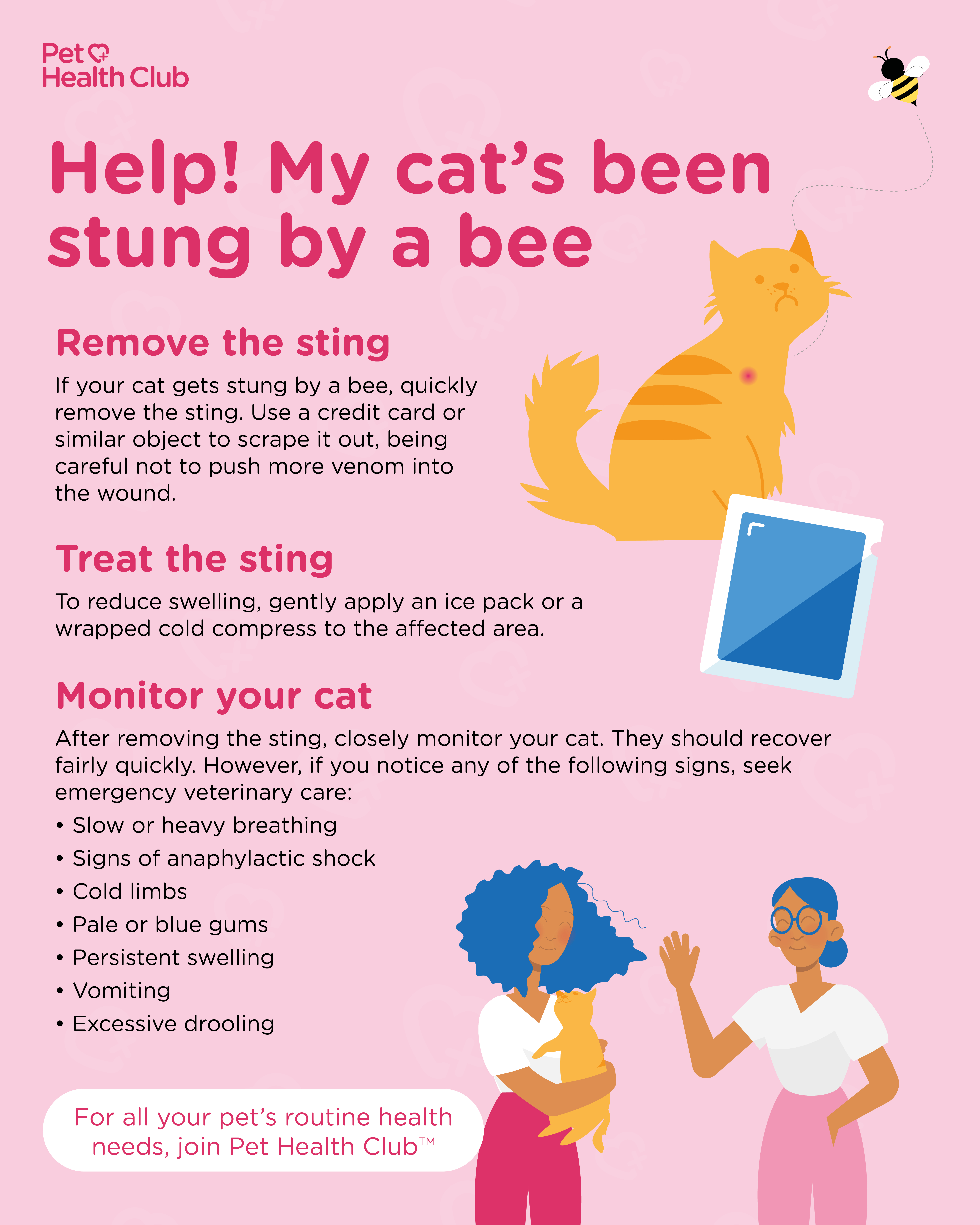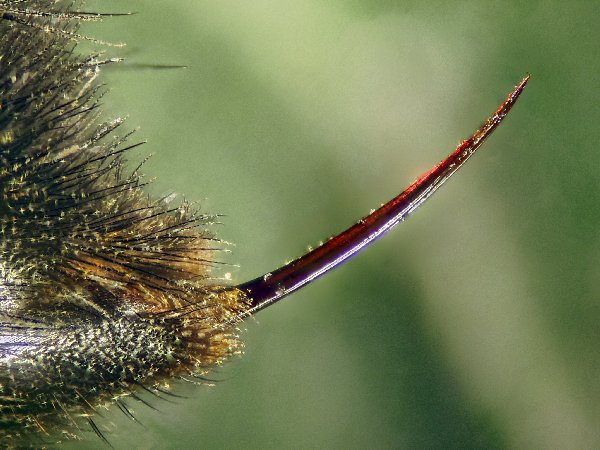What to do if your cat gets stung by a bee or wasp
First Published: 24/05/2023
Last Updated: 25/07/2024
Spring and summer is prime time for bees and wasps. Cats are natural predators who like to play with anything that flies. But what happens when they catch, paw or bite something that can fight back. While most cats will suffer nothing more than mild swelling, it could be a lot more severe if your cat is sensitive to the sting's toxicity.
This article will explain everything you need to know about bee stings, helping you keep your cat or kitten safe this summer.
Brief summary
-
Cats often initiate contact with bees and wasps while playing, and the most common areas to be stung are the paw, face, and mouth.
-
Signs your cat has been stung by a bee can include nibbling or licking, increased vocalization, swelling, pawing at the sting site, or limping.
-
While most cats will only experience mild discomfort, some may have severe allergic reactions.
-
Monitor your cat for severe allergic reactions and seek veterinary care if necessary.
Why would a bee or wasp sting my cat?
Cats are curious and predatory creatures whose natural instincts mean if they see something flying around or crawling along a windowsill, chances are they’ll pounce. This keeps cats in shape, mentally stimulated and healthy. But it's not so good when the intruder can sting its attacker.
The main reason cats get stung by bees and wasps is because they initiate contact — rarely will a bee or wasp go out of their way to attack your cat.
Most common places for your cat to be stung by bees or wasps
Your cat could be stung anywhere, but there are three common spots most likely to receive a sting:
Paw
If a bee or wasp is ambling along a windowsill or from flower to flower, there's a chance your cat will try to trap it under a paw. This can lead to paw stings easily as the bee tries to escape.
Face
Slow-moving bees, laden with pollen, will often stimulate your cat's curiosity. But, unfortunately, getting close and giving them a sniff can lead to face stings.
Mouth
Cats like to hunt when they can. So seeing a flying creature buzz around is almost impossible for them not to catch. Then, with a quick jump, the jaws snap shut, and they have a stinging creature in their mouth.
Signs your cat has been stung by bees or wasps
Cats are skilled at hiding when they're in pain, but some common signs they’ve been stung are:
- Nibbling or licking one place
- Being louder than usual or vocalising at more frequent intervals
- Swelling in one area (difficult to see in long hair breeds)
- Pawing at the sting site
- Limping or not wanting to put their paw on the ground

What happens when my cat gets stung?
Bees have stingers that are like special needles. They have three main parts: a needle part called a stylet, and two little barbed tips called lancets. The lancets are hollow and connect to a bulb at the top of the stinger. Inside the bulb, there is a venom sac that stores venom, which the bee uses when it feels threatened, like when a cat tries to catch it. The bee pushes the stinger into the cat's skin, and the barbs latch on the skin, creating a small opening for the venom to go inside.
The venom of a bee, called apitoxin, can destroy red blood cells and activate the cat’s pain receptors, which make it hurt. The venom also stops the blood from clotting at the sting site, so it can travel in the blood.
Because the venom contains histamines, it makes the spot where the cat was stung swell up. Histamines make blood vessels get bigger and tissues puff up, which causes the swelling.
How dangerous are bee and wasp stings to cats?
Most cats aren't hypersensitive to bee stings, so while the sting may be painful and uncomfortable, it should have no longer-term effects. However, just one sting can cause anaphylactic shock if your cat is allergic so beware of the signs.
Signs of an allergic reaction
The signs of anaphylactic shock can include:
- Severe wheezing and difficulty breathing
- Sudden diarrhoea or vomiting
- Excessive drooling
Your cat's gums will become very pale, almost blue, and their limbs will feel colder than usual. They may have a rapid heartbeat as well. If you think your cat is suffering from anaphylactic shock, get them to a vet immediately.
What to do if your cat is stung
The first thing you need to do if your cat has been stung by a bee is to remove the sting. This can be done using a credit card and scraping it out, taking care not to push more venom into the wound. Keep a close eye on your cat's breathing while doing this, and if it becomes slow and heavy, seek emergency vet care immediately.

Download our guide on how to help your cat after a bee sting here
Difference between wasp and bee stings
The main difference between wasp and bee stings is the barbed lancets. These barbs are only found on bees. Because they stick in the skin, when a bee tries to fly away after stinging you, they'll die almost immediately.

Wasps don't have barbs, so they keep their stinger after the attack and can sting again.
This generally means a bee sting will be more painful than a wasp sting as the stinger stays in the body longer.
Bee sting treatment and first aid
Wrap an ice pack or similar in a tea towel and gently place it on the sting to reduce swelling. Be careful not to shock your cat with the sudden cold temperature. You can also make a thick paste of water and bicarbonate soda for bee stings or use lemon juice or vinegar for wasp stings.
Monitor your cat over the next 24 hours, and if you see any signs their health is deteriorating or they are having a reaction, visit your vet immediately.
How to remove the stinger from your cat
The best way to remove a bee's stinger from your cat is to scrape something like a credit over your cat's coat. This should flick the stinger out, and you can then wipe the area down.
Never use tweezers to try and remove the stinger. This can end up squeezing more of the venom into your cat's bloodstream.
When to take your cat to the vet
You should visit your vet if
- They show signs of anaphylactic shock
- Their limbs are cold
- Their gums are pale or blue
- The swelling won't go down
- If they begin vomiting
- They begin drooling
- They are showing signs of pain, such as licking the area a lot or limping if it is on a paw
If you are worried your cat is not recovering from their bee sting, visit your vet.
Common questions
Can cats take human antihistamines?
It is safe for cats to take certain antihistamines, but they should only be used following directions from your vet. Giving your cat human antihistamines should be avoided, and you should talk with your vet about pet-safe medications. Never give your cat any medication without discussing it with your vet first.
How long does a bee sting last?
A bee sting may be swollen and painful 24 hours before it begins to go down. If, after 24 hours, it is still irritating your cat or the swelling hasn't started to go down, then you should visit your vet.
How long does it take to have an allergic reaction to a cat bee sting?
Anaphylaxis, the severe, life-threatening reaction to a bee sting, will start within two hours of the sting, although it can take longer in a cat stung by a bee. It’s important to monitor your cat for at least 24 hours after a bee sting.
Need more info?
For more information on keeping your pet safe from bee stings, or any aspect of their welfare, have a chat with your vet.
Find your nearest vet using our Find a Vet page, or speak to a vet online using Online Vets.


